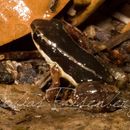en
names in breadcrumbs


Allobates marchesianus, the dull rocket frog, is a dendrobatid frog widespread and common in the Amazon basin of Brazil, Venezuela, Columbia, and Peru.Although also reported in Bolivia (Reichle and Köhler 1996), this record is thought to be in error (de la Riva et al. 2000); many species within the genus are very similar in appearance and behavior and difficult to distinguish and Caldwell et al. (2002) suggest that A. marchesianus is probably a species complex.The dull rocket frog is small, with a snout-vent length measured between 13.8-18.2 mm (males and females of similar size).These frogs are terrestrial and live in the leaf litter of primary tropical forests.They have cryptic coloration with a dark- or red-brown dorsal surface and a tan stripe down the sides of its body, a yellow throat displayed during aggressive behaviors, white belly, and bronze irises.Though they are terrestrial, their hind toes are webbed (Caldwell et al. 2002; Edwards 1974; Juncá 1998).
Males call at dawn and dusk during the rainy season to advertise for females from up to 2-3 meters from their terrestrial nest.Both male and female frogs are territorial and defend their nesting sites from conspecifics.After mating the female lays a clutch of 6-14 eggs.Males provide parental care for eggs, until they hatch about 30 days after they are laid, and then he transports the tadpoles on his back to a pond, flooded stream or other temporary water source, where they develop (Juncá 1998; Caldwell et al. 2002). Juncá (1998) describes the mating process in detail for a site near Manaus, Brazil; he also observed a female transporting tadpoles.
Allobates marchesianus, also known as the dull rocket frog, is a species of frog in the family Aromobatidae. It is found in the Amazon Basin in Brazil, Colombia, Ecuador, Peru, and Venezuela.[1][2] However, this species might represent a cryptic species complex, where at least the populations from Venezuela belong to an undescribed species.[2][3]
Adult males measure 15.0–16.6 mm (0.6–0.7 in) and adult females 15.1–17.0 mm (0.6–0.7 in) in snout–vent length. The snout is short, slightly rounded in dorsal view and acutely rounded in lateral view. The anteroventral margin of the tympanum is distinct, whereas the posterodorsal margin is obscured by the supratympanic fold. The fingers and toes bear terminal discs. The toes have very weak lateral keels and some basal webbing. The dorsum is reddish brown with small brown granules. The dorsolateral stripe is distinct, light reddish brown in color. A chocolate-brown band runs from across the snout through the eye and upper tympanum, above arm insertion, and to the groin. Females have yellow throat, chest, and belly, varying in intensity among individuals, and pale yellow blotches on the flanks. Males have light gay belly and gray to dark gray throat and chest; the flanks have white blotches.[3]
Eggs are laid in terrestrial nests guarded by the male. The male or the female transports the tadpoles to a pond or small stream.[4]
Allobates marchesianus occurs in secondary and old-growth tropical rainforests at elevations up to 800 m (2,600 ft) above sea level. It lives on the forest floor. Reproduction takes place in small pools.[1]
It is a common species but its habitat is threatened by clear cutting, logging, forest conversion, and fires. Its range includes several protected areas.[1]
Allobates marchesianus, also known as the dull rocket frog, is a species of frog in the family Aromobatidae. It is found in the Amazon Basin in Brazil, Colombia, Ecuador, Peru, and Venezuela. However, this species might represent a cryptic species complex, where at least the populations from Venezuela belong to an undescribed species.